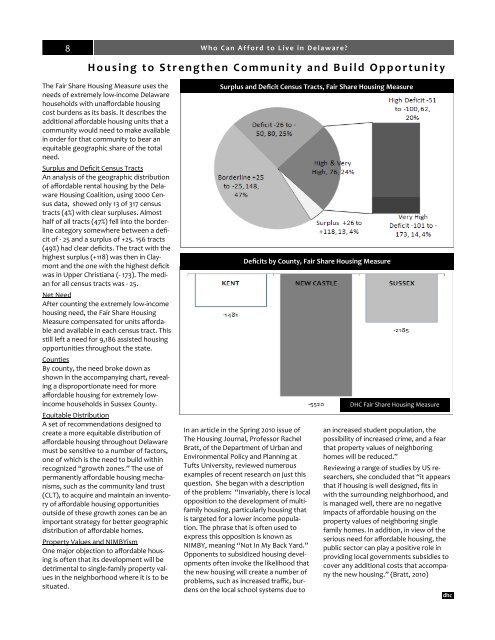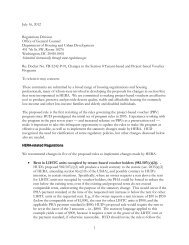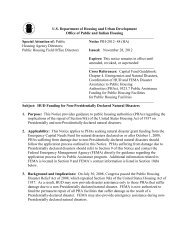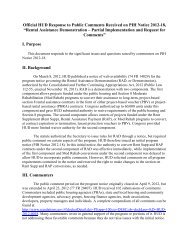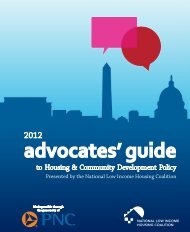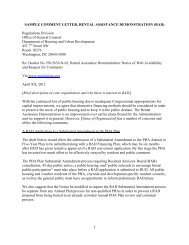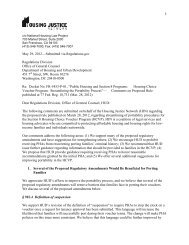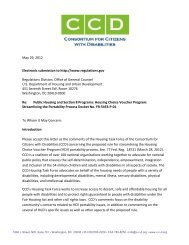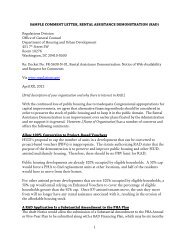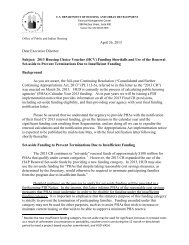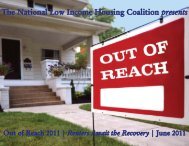Who Can Afford to Live in Delaware? - Delaware Housing Coalition
Who Can Afford to Live in Delaware? - Delaware Housing Coalition
Who Can Afford to Live in Delaware? - Delaware Housing Coalition
- No tags were found...
You also want an ePaper? Increase the reach of your titles
YUMPU automatically turns print PDFs into web optimized ePapers that Google loves.
8<br />
<strong>Who</strong> <strong>Can</strong> <strong>Afford</strong> <strong>to</strong> <strong>Live</strong> <strong>in</strong> <strong>Delaware</strong><br />
Hous<strong>in</strong>g <strong>to</strong> Strengthen Community and Build Opportunity<br />
The Fair Share Hous<strong>in</strong>g Measure uses the<br />
needs of extremely low‐<strong>in</strong>come <strong>Delaware</strong><br />
households with unaffordable hous<strong>in</strong>g<br />
cost burdens as its basis. It describes the<br />
additional affordable hous<strong>in</strong>g units that a<br />
community would need <strong>to</strong> make available<br />
<strong>in</strong> order for that community <strong>to</strong> bear an<br />
equitable geographic share of the <strong>to</strong>tal<br />
need.<br />
Surplus and Deficit Census Tracts<br />
An analysis of the geographic distribution<br />
of affordable rental hous<strong>in</strong>g by the <strong>Delaware</strong><br />
Hous<strong>in</strong>g <strong>Coalition</strong>, us<strong>in</strong>g 2000 Census<br />
data, showed only 13 of 317 census<br />
tracts (4%) with clear surpluses. Almost<br />
half of all tracts (47%) fell <strong>in</strong><strong>to</strong> the borderl<strong>in</strong>e<br />
category somewhere between a deficit<br />
of ‐ 25 and a surplus of +25. 156 tracts<br />
(49%) had clear deficits. The tract with the<br />
highest surplus (+118) was then <strong>in</strong> Claymont<br />
and the one with the highest deficit<br />
was <strong>in</strong> Upper Christiana (‐ 173). The median<br />
for all census tracts was ‐ 25.<br />
Net Need<br />
After count<strong>in</strong>g the extremely low‐<strong>in</strong>come<br />
hous<strong>in</strong>g need, the Fair Share Hous<strong>in</strong>g<br />
Measure compensated for units affordable<br />
and available <strong>in</strong> each census tract. This<br />
still left a need for 9,186 assisted hous<strong>in</strong>g<br />
opportunities throughout the state.<br />
Counties<br />
By county, the need broke down as<br />
shown <strong>in</strong> the accompany<strong>in</strong>g chart, reveal<strong>in</strong>g<br />
a disproportionate need for more<br />
affordable hous<strong>in</strong>g for extremely low<strong>in</strong>come<br />
households <strong>in</strong> Sussex County.<br />
Equitable Distribution<br />
A set of recommendations designed <strong>to</strong><br />
create a more equitable distribution of<br />
affordable hous<strong>in</strong>g throughout <strong>Delaware</strong><br />
must be sensitive <strong>to</strong> a number of fac<strong>to</strong>rs,<br />
one of which is the need <strong>to</strong> build with<strong>in</strong><br />
recognized “growth zones.” The use of<br />
permanently affordable hous<strong>in</strong>g mechanisms,<br />
such as the community land trust<br />
(CLT), <strong>to</strong> acquire and ma<strong>in</strong>ta<strong>in</strong> an <strong>in</strong>ven<strong>to</strong>ry<br />
of affordable hous<strong>in</strong>g opportunities<br />
outside of these growth zones can be an<br />
important strategy for better geographic<br />
distribution of affordable homes.<br />
Property Values and NIMBYism<br />
One major objection <strong>to</strong> affordable hous<strong>in</strong>g<br />
is often that its development will be<br />
detrimental <strong>to</strong> s<strong>in</strong>gle‐family property values<br />
<strong>in</strong> the neighborhood where it is <strong>to</strong> be<br />
situated.<br />
Surplus and Deficit Census Tracts, Fair Share Hous<strong>in</strong>g Measure<br />
Deficits by County, Fair Share Hous<strong>in</strong>g Measure<br />
In an article <strong>in</strong> the Spr<strong>in</strong>g 2010 issue of<br />
The Hous<strong>in</strong>g Journal, Professor Rachel<br />
Bratt, of the Department of Urban and<br />
Environmental Policy and Plann<strong>in</strong>g at<br />
Tufts University, reviewed numerous<br />
examples of recent research on just this<br />
question. She began with a description<br />
of the problem: “Invariably, there is local<br />
opposition <strong>to</strong> the development of multifamily<br />
hous<strong>in</strong>g, particularly hous<strong>in</strong>g that<br />
is targeted for a lower <strong>in</strong>come population.<br />
The phrase that is often used <strong>to</strong><br />
express this opposition is known as<br />
NIMBY, mean<strong>in</strong>g “Not In My Back Yard.”<br />
Opponents <strong>to</strong> subsidized hous<strong>in</strong>g developments<br />
often <strong>in</strong>voke the likelihood that<br />
the new hous<strong>in</strong>g will create a number of<br />
problems, such as <strong>in</strong>creased traffic, burdens<br />
on the local school systems due <strong>to</strong><br />
DHC Fair Share Hous<strong>in</strong>g Measure<br />
an <strong>in</strong>creased student population, the<br />
possibility of <strong>in</strong>creased crime, and a fear<br />
that property values of neighbor<strong>in</strong>g<br />
homes will be reduced.”<br />
Review<strong>in</strong>g a range of studies by US researchers,<br />
she concluded that “it appears<br />
that if hous<strong>in</strong>g is well designed, fits <strong>in</strong><br />
with the surround<strong>in</strong>g neighborhood, and<br />
is managed well, there are no negative<br />
impacts of affordable hous<strong>in</strong>g on the<br />
property values of neighbor<strong>in</strong>g s<strong>in</strong>gle<br />
family homes. In addition, <strong>in</strong> view of the<br />
serious need for affordable hous<strong>in</strong>g, the<br />
public sec<strong>to</strong>r can play a positive role <strong>in</strong><br />
provid<strong>in</strong>g local governments subsidies <strong>to</strong><br />
cover any additional costs that accompany<br />
the new hous<strong>in</strong>g.” (Bratt, 2010)


